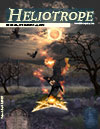 |
|
Volume 1 Issue 3 Fall 2007 |
|
|
I remember the first time I came across The Melancholy of Anatomy on the shelf in a local bookstore. The cover showed twin severed child heads, cheeks and necks webbed in meandering red veins. One head had fallen, and one was falling through the dark. On the spine were a couple of eyeballs staring out at me. Then I opened it and read some of the titles of the stories – “Blood,” “Phlegm,” “Cancer,” “Sperm.” Right off the bat, it all seemed a little too messy for me. I put the book back on the shelf. Later that day I realized that the title was a switch on Robert Burton’s Anatomy of Melancholy. I had a copy of that old tome – a big fat paperback. I’d read quite a bit of it here and there. It wasn’t the kind of book I could read straight through, but it was excellent can reading. Burton’s book is a wild collage of the medical and social history of Melancholy. There are stories, long passages from the ancient Greek and Roman philosophers and historians, and an array of remedies for the affliction. It’s a treatise of sorts, a collection of short stories, a medical text, a gallery of quotations out of history, witty and teeming with a kind of tamped down Medieval Bestiary metaphor. Burton spent a thousand pages presenting the evidence and the journey is entertaining in all kinds of ways. After reading extensively from it, I’m convinced that Metaphor, itself, is at the heart of Melancholy. I looked at the Jackson book on a few more trips to the store but didn’t buy it. Then it happened that I did a reading in New York at a Barnes and Noble for The Thackery T. Lambshead Guide to Eccentric and Discredited Diseases. It was a good time. There were a lot of writers there and we each read a little. One of the readers was Shelley Jackson, but I never put her name together with the collection I’d looked at in the store at home. Somebody at that reading told me that Jackson had this project going where she wrote a story but kept it secret. The only people who would get to read it are those who might agree to have one word of the story tattooed on their body somewhere. Only when every word of the story had been tattooed would the story be revealed and only to those who participated. There were so many wonderful implications to this enterprise – the word made flesh, the secret story, how story can make a community -- the thought of it enchanted me. When Jackson was introduced and her brief bio was read, I learned that she was the author of The Melancholy of Anatomy. Before the reading broke up, I found a copy in the store, bought it, and asked her to sign it. -Sponsored Advertisement- On the train back to Jersey, I opened the book and looked at the inscription printed in black ink – To Jeff, with slow secret emissions. That cracked me up. It was a good indication of what was to come. The book is neither messy nor dreary. There’s a strong, understated, sense of humor and Humor running through it. Sometimes it comes to the fore like in the story “Dildo,” where the dildo is written up like an entry in a Medieval Bestiary complete with quotes from the ancients – both a physical creature and the embodiment of metaphor. Other stories, each with a title indicating some process, fluid, or organ of the human body, are dream-like in their beauty, horror, weirdness, and joy. Like fairy tales or Science Fantasies set on planets with rivers of blood. The writing is smooth, readily accessible, and highly imaginative. The book has a profound sense of life to it, literally and figuratively. I could go on at length about the book as a whole, but I have to pick a story from it and move on. In my most humble opinion, I believe this book will be highly regarded far into the future. It’s thoroughly modern, but has many of the same techniques and concerns as Dante’s Divine Comedy or Ovid’s Metamorphosis. The individual story I choose from it is “Sleep.” It begins… Sleep is falling. The crumbs run in drifts down the street, collecting in the gutters. Sleep falls every day at noon here, with soothing regularity. Sometimes it melts on the way down, and falls as golden rain, or in cold weather, golden sleet, but mostly our siesta is warm and dry. The occasional sleep storm is cozy and harmless: a war waged with croutons and dinner rolls. Once, years ago, when the children were young, we woke to find we were slept in: I opened the front door and the living room filled with gold. We had a sleepball fight around the sofa, which my wife won – she was always fierce in defense of her own. The drifts blew away by evening, but our house was gilded until the next rain, and the shrubs were like torches. The narrator goes on to give a surreal disquisition about Sleep and focuses primarily on the phenomenon of the sleep substitute. Every sleeper makes a sleep substitute, crafts one out of the stuff of sleep, and this substitute will stand in for an individual at times when they’re not up to waking life – taking tests, showing up for appointments they’d rather miss. The reader is warned that one must be careful with the substitute for if it’s used to fake a suicide or stand against a bully and something dreadful happens to it, one must persevere through life all on one’s own. Substitutes can go on to have lives of their own and a substitute can marry another substitute with a 50% chance of them having a real child. At the same time the reader learns the finer points of these sleep crafted seconds, woven into the beautiful prose is another story of this airline that travels to different countries of sleep and attains high places where only certain individuals get to go. At times planes will return with no passengers on board, and the pilot will attest that all his charges got out way up above in an exotic fantasy land of cloud castles – a seemingly better place. All of this transpires in the most verbally and imagistically (is this a word?) enchanting language, and the reader might wonder, “What am I reading here?” “Is this a prose poem or just some haphazard compilation of juxtapositions of idea and imagery?” But late in the piece the reader learns that the narrator had once been a pilot for the airline and that his wife, sleeping in bed beside him, is really a sleep substitute. His real wife has left him long ago, and this fact throws the reader back to the opening paragraphs and the line that when first read seems to darken momentarily the dream like scene of the sleepball fight – “she was always fierce in defense of her own.” When these revelations come, the reader realizes that yes, “Sleep” is not just a grab bag of beautiful writing, or a prose poem, it’s a bona-fide short story in the classic sense. Aristotle’s main ingredient for drama was catharsis or change, and the ingenious construction of “Sleep” bears this out. There is another change as well, for Jackson’s writing infects the imagination and brands an indelible change in the reader’s perception as to what Story can be. I’ve seen fictional constructions like this before -- for instance in the work of Stephen Millhauser – essay-like stories, but they never achieve the palpable sense of life that “Sleep” attains. I attribute this to the writing in Jackson’s work, both incredibly controlled and totally fluid. With each surreal image there’s a choice to be made, and the choosing here seems authentic, a product of the subconscious, carrying an inherent validity. The choices don’t feel labored or intellectualized, but they are always startling and yet make perfect sense like the believable reality of a dream that causes one to cry out in the night. Whether this is a result of artifice, born of an intense practice of revision, or if it’s the product of an intuitive and blind reliance on the subconscious, or somehow both, I can’t tell. It doesn’t matter really as it makes for a wonderful reading experience. In any event, don’t let my awkward machinations about this piece put you off. The Melancholy of Anatomy and all its stories are one of the great contemporary reading experiences for lovers of the fantastic. You might want to also check out Jackson’s new novel, Half-Life. In addition she is an accomplished artist, having done book covers and illustrated children’s books. Here’s a link to her website: www.ineradicablestain.com
|
Sponsored By
Artwork By
Become a Sponsor








